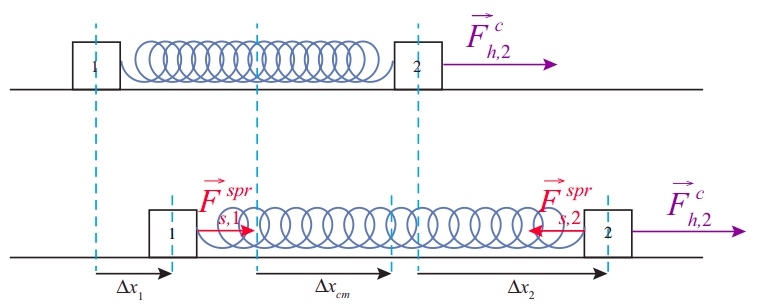10.3: The "Center of Mass Work"
( \newcommand{\kernel}{\mathrm{null}\,}\)
We should be a little bit careful when using work in the form of Equation (10.2.1). It works perfectly fine if the particle is either pointlike or rigid. In those two cases, following the principle of "the motion of the object is the same as the motion of the center of mass" from Section 4.3, we can consider the entire formula to apply to the center of mass, like:
where Kcm, the translational kinetic energy, is, as usual, Kcm=12Mv2cm, and Δxcm is the displacement of the center of mass. We are also assuming the force is constant in this case. The result (???) holds for an arbitrary system, as long as Fext,net is constant, and can be generalized by means of an integral (as in Equation (10.2.6)) when it is variable.
So it seems that we could define the left-hand side of Equation (???) as “the work done on the center of mass,” and take that as the natural generalization to a system of the result (10.2.8) for a particle. In fact, it's a bit more subtle than that, so we want to discuss that subtly in this section.
First, it seems that it is essential to the notion of work that one should multiply the force by the displacement of the object on which it is acting. More precisely, in the definition (10.2.1), we want the displacement of the point of application of the force1. But there are many examples of systems where there is nothing at the precise location of the center of mass, and certainly no force acting precisely there.
This is not necessarily a problem in the case of a rigid object which is not doing anything funny, just moving as a whole so that every part has the same displacement, because then the displacement of the center of mass would simply stand for the displacement of any point at which an external force might actually be applied. But for many deformable systems, this would not be case. In fact, for such systems one can usually show that Fext,netΔxcm is actually not the work done on the system by the net external force. A simple example of such a system is shown below, in Figure 10.3.1.

In this figure, the two blocks are connected by a spring, and the external force is applied to the block on the right (block 2). If the blocks have the same mass, the center of mass of the system is a point exactly halfway between them. If the spring starts in its relaxed state, it will stretch at first, so that the center of mass will lag behind block 2, and Fch,2Δx2, which is the quantity that we should properly call the “work done by the net external force” will not be equal to Fch,2Δxcm.
The best way to understand what's happening here is to think about all the sources of energy in the system - if you pull on that block-spring system, you are certainly going to add energy to it, but think about what happens if you follow this picture for a while. Eventually, you will have both blocks moving together, but the spring will be oscillating in some kind of consistent manner, therefore storing energy in the form of 12kx2. So while Equation (???) might not be literally true, it's reasonable to think we could write a variation of it that looks like
Work done by external forces=Change of internal energy of the system.
In fact, we will study conservation of energy in these cases in Chapter N8. For the moment, if we just assume our systems are rigid, with no internal energy, we can freely use Equation (???).
1As the name implies, this is the precise point at which the force is applied. For contact forces (other than friction; see later), this is easily identified. For gravity, a sum over all the forces exerted on all the particles that make up the object may be shown to be equivalent to a single resultant force acting at a point called the center of gravity, which, for our purposes (objects in uniform or near-uniform gravitational fields) will be the same as the center of mass.


